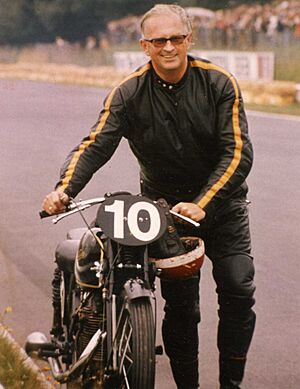Helmut Krackowizer facts for kids
Helmut Krackowizer (29 April 1922 – 22 October 2001) was an Austrian motorcycle racer and motor journalist with an international reputation who specialized in vintage motorcycles.
Early life
Born in Austria in 1922, while he was a schoolboy Krackowizer started to create motorcycle drawings. He rode his first motorcycle, a 250 cc NSU, at the age of 16, and soon replaced this motorcycle with a 500 cc Norton "International".
During his school summer vacations, Krackowizer worked as a mechanic and went to races whenever possible. In 1932, he attended one of the first races on the Gaisberg near Salzburg. He took advantage of any opportunity to ride a motorcycle, buy one (A Rudge 250 cc two valves, his first racing motorcycle after the Second World War), or to rescue one. He saw the end of the war as a fighter controller of the Air Signal Corps in a night interception troop – on a motorcycle – in Norway.
The Motorcycle Professor
After Krackowizer retired from active racing in 1955, he began to track down historic Motorcycles all over Europe. He kept some of these finds and had them restored, he exchanged others and sold them again. In 1967, he founded the third Motor Veterans Club in Austria, the Motor Veterans Club Salzburg. In 1976, Krackowizer also became president of the Austrian Motor Veterans Association for a short time.
He fulfilled a lifelong dream by realizing the great motor veteran race on the Salzburgring, the "Oldtimer Grand Prix", which took place between 1974 and 1987. Well over 100 automobiles and up to 300 motorcycles came to this event at the Salzburgring. In the best years. Mercedes Benz sent the famous Silver Arrows, BMW, and Audi that brought historical racing cars from their museums to Salzburg.
However, his efforts to establish a Motor Veteran Museum in Salzburg were unsuccessful. Attempts were made to convert the Stadl in the Hellbrunn Palace Park for this purpose, but these failed due to bureaucratic considerations on the part of the municipality of Salzburg. Thus, some collections of vintage motorcycles and automobiles whose owners Krackowizer had already won over for the project (such as Walter Brandstetter from St. Pölten) went to domestic and foreign motor museums. As of 2019, no suitable space for historical technology (of all kinds) has been created in Salzburg to present rarities to posterity.
Career
Motorcycle racing
In the autumn of 1946, he rode his first motorcycle race with his Rudge 250 cc under heavy rain during the first post-war race in Salzburg-Nonntal, Austria. He came in third.
Then, in the spring of 1947, the first dirt track race in Salzburg, organized by the just-founded SAMTC (Salzburg automobile motorcycle and touring club), attracted 20.000 spectators on the trotting racecourse in Salzburg-Aigen. The SAMTC's first motorcycle race took place on the motorway in Salzburg-Liefering on 6 July 1947. In 1958, this race became the Grand Prix of Austria for motorcycles, which moved later on the motorway Anif-Grödig, also near Salzburg, and at the end on the Salzburgring, where the race had been upgraded in 1970 to a world champion race.
In that motorcycle race on 6 July 1947, Krackowizer won the junior class 250 cc on Rudge in 44:32,8 min., followed by the Salzburgians Fritz Walcher on New Imperial with a time of 46:43,4 min. and Richard Kwitt on Puch in 46:43,4 min. The race led over 15 laps, which corresponded to a distance of 63 kilometers (39 mi). Krackowizer was then also in the senior race three laps into the lead before he had to abandon because of a defect. This was the beginning of his motorcycle racer career lasting until 1955.
The year 1947 became one of the most successful racing years for him. Among other races he took part in Austria in Rankweil and Lustenau (Vorarlberg), in the Innsbruck-Hungerburg hill climb race, in Graz-Lazarett Siedlung and Ries hill climb race, Pötschen Pass as well as in Liechtenstein at the Triesenberg. The year's result of 1947: three first places, two-class records, two second places, and two fourth places – the most successful racer of Austria in class A to 250 cm3. Today one would say "Austrian motorcycle champion".
In 1948, he intended to take part in the Isle of Man TT, but failed to do so because of missing border documents at the Swiss border. In the following years, he rode with changing success also abroad, e.g. in Olten and Erlen, at the "Schauinsland" hill climb race, in Ingolstadt and the Norisring in Nuremberg as well as on the Hockenheim.
Over the years he rode several motorcycle marks as there had been: Rudge]250 cm3, Velocette KTT MK VIII 350 cm3 ex Binder, BSA Gold Star 350 cm3 Lohner scooter, Norton 500 cm3, AJS, Puch, and others. In 1955, he retired from his active motorcycle racing career.
Journalism
After he graduated from the University of Economics in Vienna, he began his profession in 1952, at the factory Eternit at Vöcklabruck, Upper Austria. He moved to Salzburg in 1955 to start his career as public relations and advertising manager at Porsche Austria. Later on, he moved to Mercedes Benz (1964) and British Leyland (1969). His last job until his retirement in 1987 had been with Chrysler (renamed Talbot and finally merged with Peugeot).
During this time, he wrote articles on motorcycle races for various magazines within German and English-speaking areas. Moreover, he revisited his childhood hobby of drawing famous racing motorcycles. His drawings were first published with great success in 1965. Having written and published books on motorcycles, including Motorcycle Sport and The History of Famous Makes of Motorcycle, he returned to his drawings, particularly pencil drawings showing fine details of a motorcycle. He continued this hobby until the last months of his life.
On the morning of 22 October 2001, he died after suffering his third heart attack on Monday, 15 October, at the age of 80.


